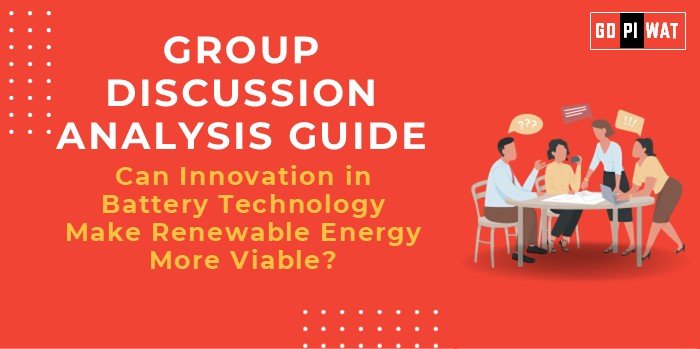📋 Group Discussion Analysis Guide
🔋 Can Innovation in Battery Technology Make Renewable Energy More Viable?
🌟 Introduction to the Topic
Opening Context: “With the global shift towards renewable energy, the challenge of energy storage remains pivotal. Advancements in battery technology could be the linchpin for achieving a sustainable energy future.”
Topic Background: The role of batteries in stabilizing renewable energy sources like solar and wind has gained prominence as countries aim for net-zero emissions. Technologies like lithium-ion and solid-state batteries are leading the charge, with innovations continually reshaping the industry.
📊 Quick Facts and Key Statistics
- ⚡ Renewable Energy Usage: Renewable energy accounted for 29% of global electricity generation in 2023 (IEA).
- 📉 Battery Cost Decline: Lithium-ion battery costs dropped by 89% between 2010 and 2023 (BNEF).
- 🔋 Energy Storage Growth: Global battery storage capacity exceeded 60 GW in 2023, projected to reach 300 GW by 2030 (IRENA).
- 🌍 CO2 Emission Reduction: Potential to cut 5-7 Gt of CO2 annually by 2050 with enhanced battery systems (IEA).
- 🇮🇳 India’s Target: Aiming for 500 GW renewable energy capacity by 2030, backed by battery storage initiatives (MNRE).
👥 Stakeholders and Their Roles
- Governments: Policy formulation, subsidies for R&D, and setting emission targets.
- Private Sector: Investments in innovation, scaling battery manufacturing.
- Researchers and Scientists: Development of cost-effective, efficient technologies like solid-state and sodium-ion batteries.
- Consumers: Adoption of electric vehicles and renewable energy storage systems.
- Environmental Organizations: Advocating for sustainable practices and assessing ecological impacts of mining raw materials.
🏆 Achievements and Challenges
🌟 Achievements:
- ✅ Efficiency Gains: Lithium-ion batteries achieve 90-95% efficiency.
- 🚗 EV Revolution: Battery technology catalyzed a 26% rise in global EV sales in 2023 (IEA).
- 🌐 Renewable Storage Success: Australia’s Hornsdale Power Reserve demonstrated grid stabilization using large-scale batteries.
- 📉 Cost Reductions: Energy storage became economically competitive with coal in 2022.
⚠️ Challenges:
- ⛏️ Resource Dependency: Reliance on rare earth elements like lithium and cobalt.
- ♻️ Recycling Gap: Only 5% of lithium batteries are recycled globally.
- 🔋 Intermittency Issues: Current battery capacities insufficient for large-scale, long-duration storage.
Global Comparisons:
- 🇩🇪 Germany: Leveraged pumped hydro and battery storage for renewable integration.
- 🇨🇳 China: Leading battery production and deployment, accounting for 60% of global output.
Case Studies:
- 🇮🇳 India’s Green Energy Corridor: Enhances renewable integration using grid-scale battery storage.
- 🇺🇸 California: World’s largest lithium-ion storage facility, Moss Landing.
📑 Structured Arguments for Discussion
- Supporting Stance:
“Battery innovations like Tesla’s Megapack prove that renewables can rival traditional energy sources in reliability.”
- Opposing Stance:
“Battery production’s environmental cost and raw material extraction challenge its long-term sustainability.”
- Balanced Perspective:
“While innovation in battery technology is critical, complementary measures like grid upgrades and diversified storage are necessary.”
✨ Effective Discussion Approaches
- Opening Approaches:
- 📊 Statistical Impact: “With battery costs plummeting by 89% since 2010, the stage is set for renewable energy to dominate.”
- ⚠️ Problem-Driven: “Renewable energy’s intermittency remains a bottleneck; can batteries solve this?”
- 🌐 Case Study Opening: “The Hornsdale Power Reserve in Australia proved how batteries stabilize energy grids during outages.”
- Counter-Argument Handling:
- Rebuttal Example: “While lithium mining is a concern, emerging technologies like sodium-ion batteries reduce environmental risks.”
🔍 Strategic Analysis of Strengths and Weaknesses
- 💡 Strengths: Cost reductions, enhanced efficiency, and scalability.
- ⚠️ Weaknesses: Resource-intensive, recycling challenges.
- 📈 Opportunities: Emerging technologies, policy support, and global energy demand.
- 🌋 Threats: Geopolitical dependency on raw materials and ecological impact.
🏫 Connecting with B-School Applications
- Real-World Applications:
- 📊 Potential projects on cost modeling, supply chain management of battery components, and renewable energy operations.
- Sample Interview Questions:
- “What are the key challenges in battery recycling?”
- “How can innovation in battery storage accelerate renewable adoption?”
- Insights for B-School Students:
- 🌱 Explore collaborations in renewable energy financing.
- ♻️ Analyze lifecycle assessments of batteries for sustainable energy solutions.


